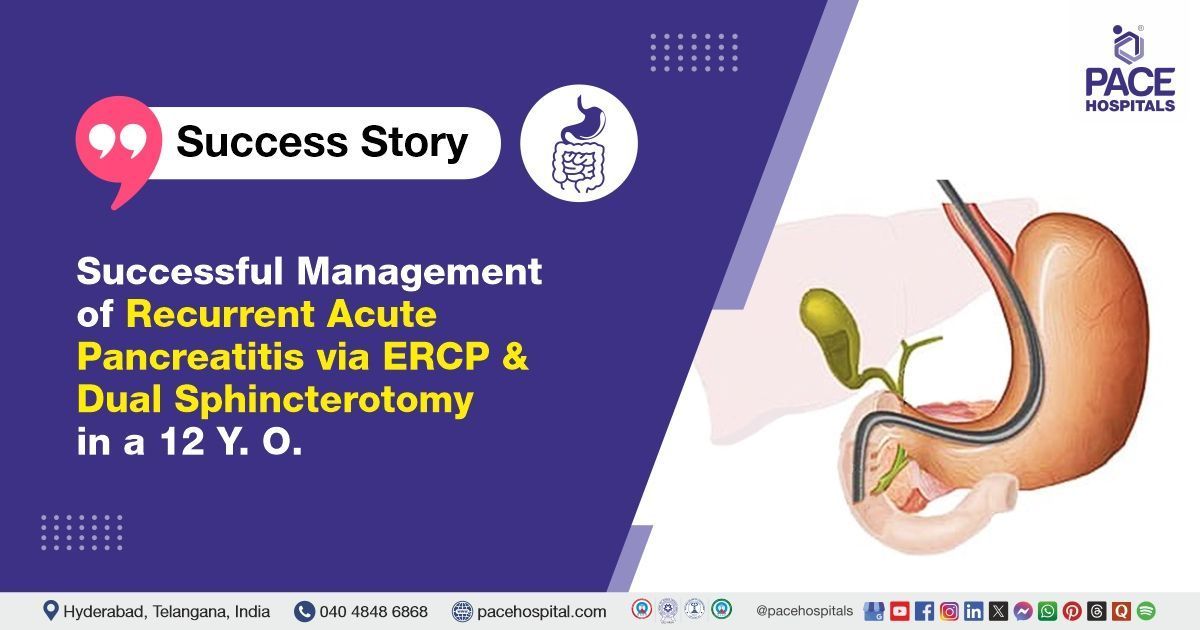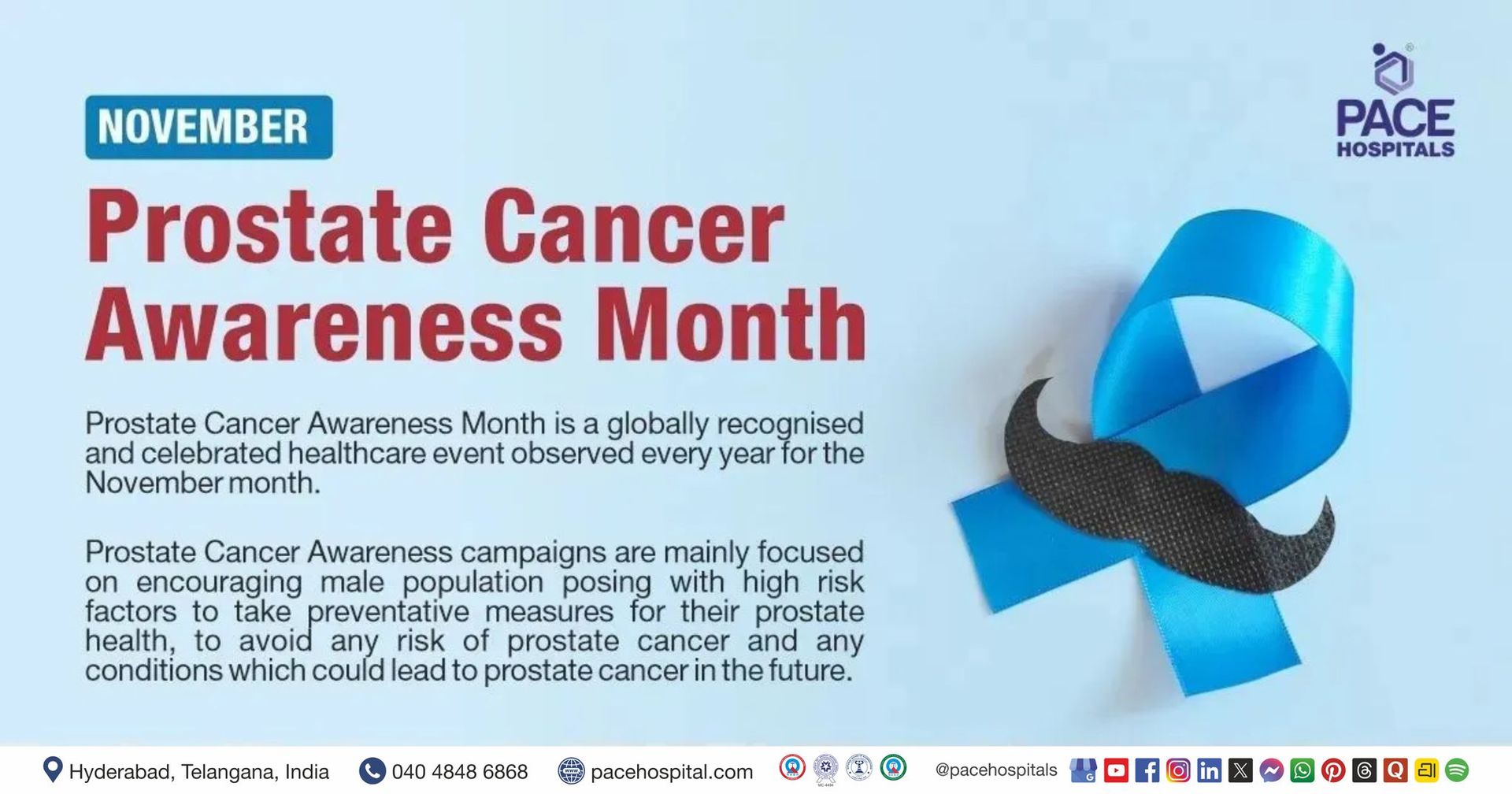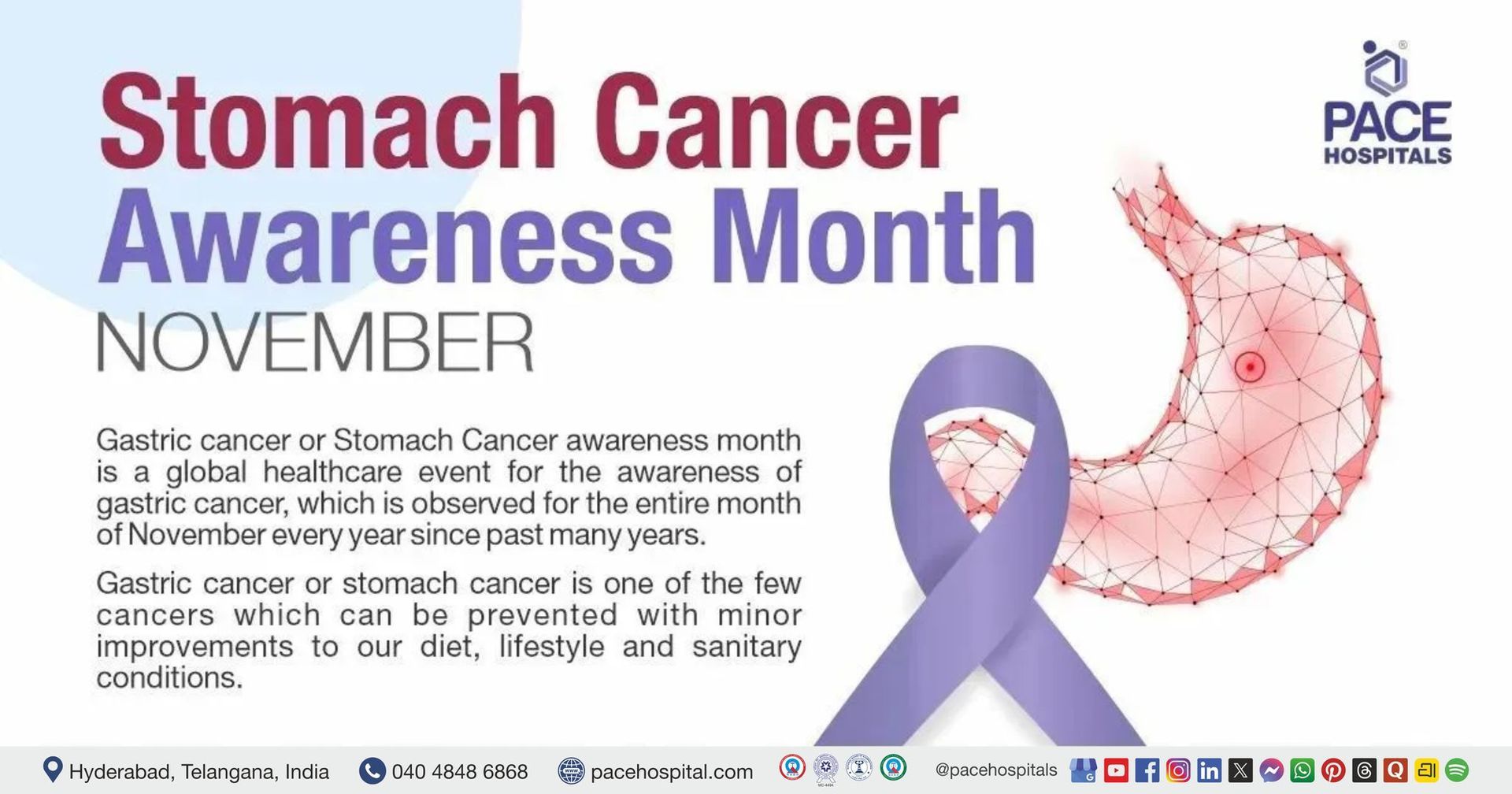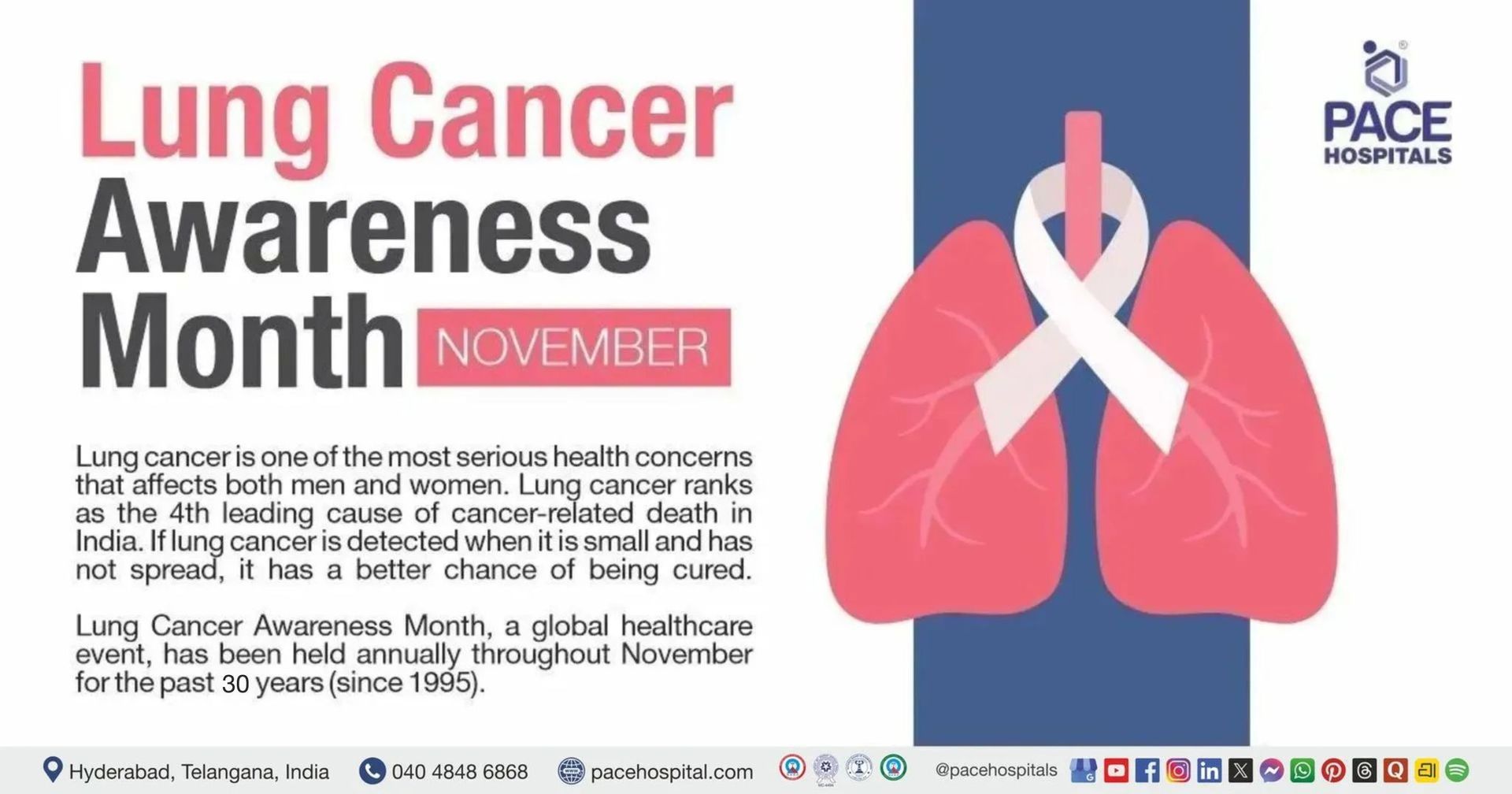Successful Management of Recurrent Acute Pancreatitis via ERCP & Dual Sphincterotomy in a 12-Year-Old
PACE Hospitals
The Gastroenterology team at PACE Hospitals successfully performed an ERCP with pancreatic and biliary sphincterotomy in a 12-year-old girl with a history of six episodes of acute pancreatitis in the past year who presented with epigastric pain for four days, worsened by food intake and associated with vomiting, and was diagnosed with acute pancreatitis on imaging, following which the procedure relieved ductal obstruction leading to significant symptomatic improvement and helped prevent further recurrences.
Chief Complaints
A 12-year-old girl with a
BMI of 17.2 presented to the Department of Gastroenterology at
PACE Hospitals, Hitech City, Hyderabad, with complaints of epigastric pain for the past four days which was dull aching in nature, non-radiating and progressively worsened after food intake, and was associated with multiple episodes of vomiting, prompting evaluation and further management.
Past History
The patient had a known history of recurrent
acute pancreatitis, with six documented episodes within one year, each characterized by similar complaints of abdominal pain and vomiting, requiring repeated hospital visits and medical management, indicating a persistent underlying pancreatic pathology that warranted further evaluation and definitive intervention.
General Examination
On examination, the patient was conscious, alert, and hemodynamically stable. She appeared pale but had no signs of icterus or cyanosis. Abdominal examination revealed tenderness in the epigastric region without guarding or rigidity. Cardiovascular and neurological examinations were within normal limits for her age.
Diagnosis
Upon admission, the patient underwent a comprehensive clinical examination and a detailed review of her previous medical records by the Gastroenterology team. Based on her presenting symptoms, recurrent acute pancreatitis was suspected as the underlying condition contributing to her current episode and overall clinical deterioration.
To confirm the diagnosis and evaluate the extent of pancreatic involvement and potential complications, a series of targeted investigations were conducted.
Blood investigations revealed elevated serum lipase levels, indicating active pancreatic inflammation.
An abdominal ultrasound showed minimal gallbladder sludge, with no evidence of peripancreatic oedema.
Magnetic Resonance Cholangiopancreatography (MRCP) revealed features suggestive of mild acute pancreatitis, with mild dilation of the main pancreatic duct (MPD) in the distal body and tail (up to 3.5 mm), indicative of early chronic pancreatitis.
The MPD in the proximal body and head appeared attenuated, likely due to acute inflammation. Additionally, a possible pancreatic divisum was noted.
Upper gastrointestinal endoscopy revealed a normal study, effectively ruling out any upper GI tract pathology as a contributing factor to her symptoms. The combined findings from imaging and laboratory investigations supported a diagnosis of acute-on-chronic pancreatitis with underlying ductal abnormalities, warranting endoscopic intervention.
Based on the confirmed diagnosis, the patient was advised to undergo Recurrent Acute Pancreatitis Treatment in Hyderabad, India, under the expert care of the Gastroenterology Department.
Medical Decision Making (MDM)
After a thorough consultation with the consultant gastroenterologists, Dr. Govind R Verma, Dr. Sudhir, and Dr. Padma Priya, a comprehensive evaluation was carried out to determine the most appropriate diagnostic and therapeutic approach for the patient.
Based on their expert assessment, it was concluded that ERCP with Pancreatic and Biliary sphincterotomy would be the most effective procedure to address the patient's condition.
Surgical Procedure
Following the decision, the patient was scheduled for an ERCP with Pancreatic and Biliary Sphincterotomy procedure in Hyderabad at PACE Hospitals, under the expert care of the Gastroenterology Department.
The patient successfully underwent the scheduled procedure, which involved both pancreatic and biliary sphincterotomy. This combined endoscopic intervention was performed to relieve ductal obstruction, enhance pancreatic and biliary drainage, and address any anatomical communication between the two ductal systems. The approach was aimed at reducing intraductal pressure, alleviating symptoms, and minimizing the risk of future acute exacerbations.
Clinical Significance of the Procedure
ERCP with pancreatic and biliary sphincterotomy is a minimally invasive endoscopic procedure widely used in the diagnosis and treatment of pancreaticobiliary disorders. In this case, the approach involved the endoscopic insertion of a catheter through the duodenum to access the pancreatic and bile ducts. A sphincterotomy—an incision to enlarge the ductal opening—was performed to improve fluid outflow, and stenting was used as needed to support drainage. This procedure plays a pivotal role in the management of chronic pancreatitis and its complications by relieving pressure in the pancreatic ducts, preventing further episodes of ductal inflammation, and potentially minimizing long-term pancreatic damage.
Postoperative Care
The patient’s postoperative recovery was smooth and uneventful. She was managed in the Medical Intensive Care Unit (MICU) with close monitoring, supportive care, and nutritional management. Further follow-up focused on symptom control, nutritional support, and monitoring for potential complications or recurrence. Multidisciplinary input from the gastroenterology, nutrition, and endocrinology teams was provided to support her long-term recovery and pancreatic health.
Outcome and Further Plan
Following the procedure, the patient showed signs of clinical improvement. With clinical stability achieved, the patient was discharged with appropriate medical advice and follow-up instructions.
Discharge Medications
Upon discharge, the patient was prescribed a combination of medications including antibiotics, enzyme supplements, proton pump inhibitors (PPIs), analgesics, and nutritional supplements to support pancreatic healing, control any residual infection, reduce gastric acid secretion, manage pain effectively, and enhance nutritional recovery.
Dietary
The patient was advised to follow a low-fat diet to promote optimal nutritional recovery and support pancreatic healing. A low-fat diet is crucial in reducing the burden on the pancreas by minimizing the need for digestive enzymes, which aids in preventing further pancreatic stress. Additionally, this dietary modification helps in managing symptoms and preventing complications such as further inflammation or digestive disturbances. The dietary plan was tailored to ensure adequate calorie intake and proper nutrition while avoiding foods that could exacerbate her condition, with regular follow-up to monitor her progress and make any necessary adjustments to her diet.
Emergency Care
The patient was informed to contact the Emergency ward at PACE Hospitals in case of any emergency or development of symptoms like fever, abdominal pain, or vomiting.
Review and Follow-up Notes
The patient was advised to return for a follow-up appointment with the Gastroenterologist in Hyderabad at PACE Hospitals, one month after discharge, with a prior appointment.
Conclusion
This case underscores the effective management of recurrent acute pancreatitis in a 12-year-old patient through a comprehensive approach that included endoscopic interventions, specifically ERCP with pancreatic and biliary sphincterotomy, in conjunction with supportive care and tailored nutritional management.
Role of ERCP with Sphincterotomy in Managing Pancreatic and Biliary Ductal Disorders
Endoscopic Retrograde Cholangiopancreatography (ERCP) plays a crucial role in the management of pancreatic and biliary ductal diseases, particularly in sphincterotomy procedures. ERCP allows for direct visualization of the pancreatic and biliary ducts, enabling the identification of blockages, strictures, or other abnormalities that may be causing symptoms like pain, jaundice, or pancreatitis. During sphincterotomy, the endoscope is used to create an incision in the sphincter of Oddi, which regulates the flow of pancreatic and biliary fluids into the small intestine. This incision helps to relieve pressure, improve drainage, and restore normal fluid outflow, thereby reducing the risk of further inflammation and complications like pancreatitis or cholangitis. ERCP with sphincterotomy is particularly effective in treating conditions such as pancreatic ductal obstruction, biliary stones, or strictures, and it provides a minimally invasive alternative to surgery when performed by an experienced gastroenterologist / gastroenterology doctor.
Share on
Request an appointment
Fill in the appointment form or call us instantly to book a confirmed appointment with our super specialist at 04048486868











